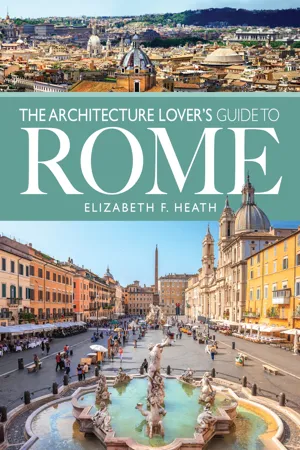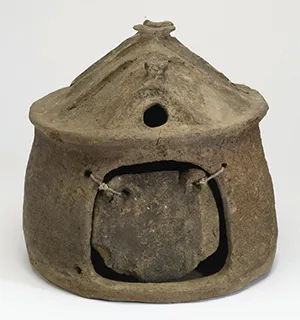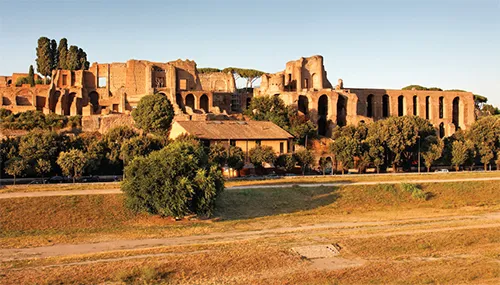![]()
1
ROMULUS PUTS DOWN ROOTS
The Palatine Hill and the Romulan Hut
The origins of Rome are a blend in equal parts of legend, hypothesis and verifiable evidence. The architecture of Rome, along with first-person accounts written by the likes of Julius Caesar, Augustus, Livy and Plutarch, is perhaps the most essential aspect of that verifiable evidence.
The legend is that twin brothers Romulus and Remus, abandoned as infants and suckled by a she-wolf, were the children of Rhea Silvia, a vestal virgin seduced by Mars, the god of war. When, as adults, the twins quarrelled about where to found a new settlement and who would lead it, Romulus killed his brother. On 21 April 753 BCE, he is said to have founded his new city on the Palatine Hill, named it after himself and made himself its first king. He is credited with creating the Senate, establishing military and religious customs and a pantheon of gods, and codifying Rome’s earliest laws regarding property, civil rights and citizenship. Some fifty years into his rule, he is said to have disappeared in the midst of a storm, only to be installed on Mount Olympus as the god Quirinus.
As Rome transformed from primitive riverine settlement to an organised republic and, centuries later, an empire, this foundation myth endured and was enhanced. By the first century BCE, Virgil, at the behest of Emperor Augustus, nephew and adopted son of Julius Caesar, had penned his epic poem, The Aeneid. It traced the journey of Aeneas, one of a handful of survivors of the Sack of Troy, from the near east to Carthage and Sicily and eventually, to the Italian peninsula. Virgil’s epic firmly affixed Aeneas as the heroic forbearer of the Roman people.
The Aeneid also established a direct bloodline from Aeneas to Rhea Silvia. Because Aeneas was the son of Venus (the Roman version of the Greek Aphrodite), his progeny, including Romulus and Remus, were therefore of divine origin, as were the emperors of the Julian family, including Julius Caesar and Augustus. Romulus himself was deified after his death; 21 April is still celebrated as the anniversary of the founding of Rome.
An Iron Age funerary urn suggests the likely shape of the Romulan Hut. Walters Art Museum.
The accepted hypothesis is that sometime in the eighth or ninth century BCE, a permanent settlement was established on the Palatine Hill, which was bordered on one side by the Tiber River and on the other by a swampy valley – the area that would become the Roman Forum. Other Latin tribes built similar, simple pastoral communities on neighbouring hills; eventually these were absorbed, either organically or by force, into the city that would grow into the Roman Republic.
The authenticity of Romulus as a historical figure is far less widely accepted. For the most part, Classical scholars believe that Romulus and Remus were not actual historical figures, but an amalgam of several Greek and Latin legendary and real characters. They theorise that even the name ‘Romulus’ was created retroactively to support the foundation myth as it was codified into Roman history.
The verifiable evidence is where architecture comes in. The Palatine Hill is home to one of the oldest archaeological remains in Rome, the so-called Romulan Hut, or Casa Romuli. This Iron Age (900–700 BCE) hut was made of wattle and daub, with a straw roof, a small awning and an animal-skin flap at the doorway. All that remains today are the postholes, which confirm its circular shape. During a 2006 excavation in the Roman Forum, tombs were found containing hut-shaped funerary urns. These dated to the same period and culture as the hut remains on the Palatine. Since it was customary for the ashes of the dead to be housed in clay urns that mimicked the shape of their dwellings, the urns further corroborate the style of the hut.
The site of the Romulan Hut was a place of reverence in Republican Rome, and it was maintained and restored through the Late Republican era. The Palatine Hill became the site of Imperial residences; Augustus symbolically chose a location adjacent to the Romulan Hut to build his palace, large parts of which are still extant today.
Modern visitors to the Palatine Hill can visit the Romulan Hut (Casa Romuli), but some imagination is needed to envision what it once looked like. A cluster of postholes – the impressions left where wooden posts, since deteriorated, once held up the roof – are etched into the tufa bedrock that forms much of the Palatine. Crisscrossing these scant remains are Republican- and Imperial-era foundation walls and haphazardly placed marble fragments.
While the name Casa Romuli takes some creative license, the term correctly links the remains to the approximate era of the Romulus and the founding of Rome in the eighth century BCE. Still, the presence of the hut remains does not confirm a solid date, prove Rome’s foundation myth or verify the existence of Romulus; it only provides evidence that at least as early as 800–701 BCE – and possibly several hundred years earlier than that – a permanent settlement existed on the Palatine.
Postholes and foundation floor of the Casa Romuli, with later walls and foundations built on top. Vitold Muratov/Wikimedia Commons.
Unlike the largely accepted consensus reached among academics concerning the Romulan Hut, interpretation of a 1988 excavation has generated controversy and a fair amount of scepticism. During a multi-year excavation on the north-eastern slope of the Palatine Hill, an archaeological team unearthed a wall built from red tufa blocks. It fronted a large, natural gully that had been made steeper as a result of human excavations – typical of early defensive walls. Pottery sherds and other physical evidence date the wall to at least the seventh century BCE, and possibly earlier.
Ancient Roman historian Livy wrote that: ‘Romulus’s first act was to fortify the Palatine, the scene of his upbringing.’ Other ancient sources also claim that Romulus ordered the wall built as his first step in establishing his settlement.
Some scholars have pointed to Livy, Virgil and other sources of the foundation myth, together with the discovery of the wall, to claim that the discovery was of a specific moment in ancient history – when Romulus drew the boundary of his new city and ordered that a wall be built to defend it. This theory supports the ‘historicity,’ or actual existence of Romulus. Critics of the thesis argue that science cannot use ancient literature to prove the origins of the wall, and in turn use the wall to prove the veracity of the ancient literature – and that of Romulus himself.
Still, like the Romulan Hut, the Palatine Wall, which can today be seen at the base of the Palatine Hill, west of the House of the Vestal Virgins, does fill in some of the blanks of the earliest days of Rome. Also like the hut, it further supports the theory that the city that would become Rome did in fact emerge from humble beginnings on the Palatine Hill and, in fewer than 1,000 years, grow to control the entire Mediterranean, Western Europe, the Isle of Britain, Eastern Europe, the Middle East and the southern half of the Black Sea.
i
HOW TO SEE IT: To see the remains of the Casa Romuli, visit the Palatine Hill archaeological area. A combined ticket includes admission to the Palatine, the Colosseum and the Roman Forum. The site opens at 8.30 am and remains open until 4.30 or 5 pm during winter months, and until 7.15 pm during peak summer season. Check https://www.coopculture.it/en/heritage.cfm?id=4 for current information. Also look for information about a S.U.P.E.R. Ticket, which includes admission to the houses of Livia and Augustus and other sites otherwise inaccessible. Due to long lines at the Colosseum, we recommend you begin your tour at the Palatine, where there is never a line to enter and crowds are far less dense. Then continue on to the Forum and Colosseum.
![]()
2
FROM KINGDOM TO REPUBLIC
The Temple of Jupiter Optimus Maximus & the temples of Portunus & Hercules Victor
A timeline of the earliest centuries of Rome is speculative at best, as it relies on sources that, while ancient, were recording a history that had already unfolded hundreds of years in the past. Dionysius of Halicarnassus and Livy, the two major sources for the story of the foundation of Rome, both lived at the turn of the millennium – at least 800 years after Romulus.
While Dionysius’ writings dealt primarily with Romulan legend, Livy’s History of Rome, recorded at the end of the first century BCE, chronicled the history of the city as it evolved from kingdom to republic. The written sources and oral histories Livy relied on would have been created to cast a flattering light on the actions of Rome’s most-favoured leaders. Lines were blurred between divine intervention and historical fact, both as a means of reinforcing the concept of Rome’s manifest destiny and simply for the sake of telling a better story.
After Romulus’ death, Rome is said to have been ruled by a succession of kings, the last three all of Etruscan origin, meaning they came from the region north of Rome that includes present-day northern Lazio (the region of Rome), Umbria and Tuscany (the latter of which takes its name from the Etruscans). Ostensibly to offset the powers of the monarchy, Rome had a Senate, a body which had existed since the time of Romulus. Rome’s last king, Etruscan Lucius Tarquinius Superbus, was unpopular with the Roman people and is said to have abused his power and undermined the Senate. He was overthrown and banished from the city and in 509 BCE the Roman Republic was formed. Through civil wars, far-reaching conflicts and conquests of territories throughout Europe, North Africa and the Middle East, the Republic lasted until 27 CE.
While the historicity and chronology of the Etruscan kings and the formation of the Republic can never be precisely verified, the influence of Etruscan culture on Rome is extensive and demonstrable. From the Etruscans, Rome absorbed its earliest rituals and systems of worship, including its three most important deities: Juno, Minerva and Jupiter, the latter the mythological equivalent of Zeus. From the Etruscans, Romans learned how to build roads and municipal projects (Rome’s massive drainage canal, Cloaca Maxima, was built by the Etruscan kings and still empties into the Tiber today) and, most importantly, they learned how to build temples.
The Temple of Jupiter Optimus Maximus
That Livy and Dionysius of Halicarnassus relied on unverifiable sources for their written histories of Rome is certain, but what is also certain is that when these chroniclers were active in Rome, they frequently set eyes on the city’s most important ancient temple, around which every significant ritual, political or military event in the history of Rome centred: the Temple of Jupiter Optimus Maximus.
Also known as the Temple of Capitoline Jupiter, the Temple of Jupiter Optimus Maximus – which translates to the Jupiter ‘best and greatest’ – was a massive structure set at the top of the Capitoline Hill and visible from virtually every part of Rome. It was built on the orders of Lucius Tarquinius Superbus, but would be dedicated around the time of the formation of the Republic, in...





